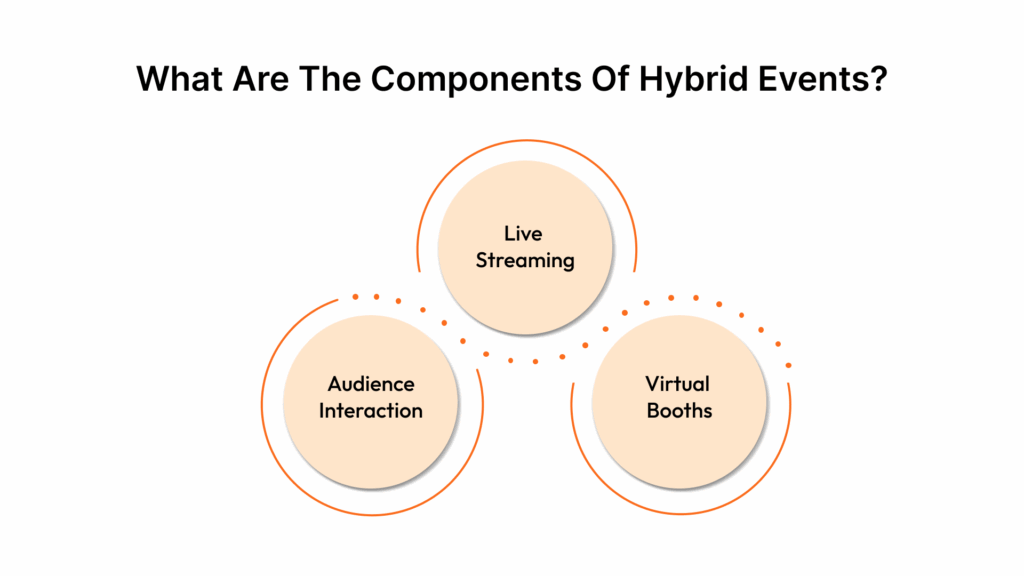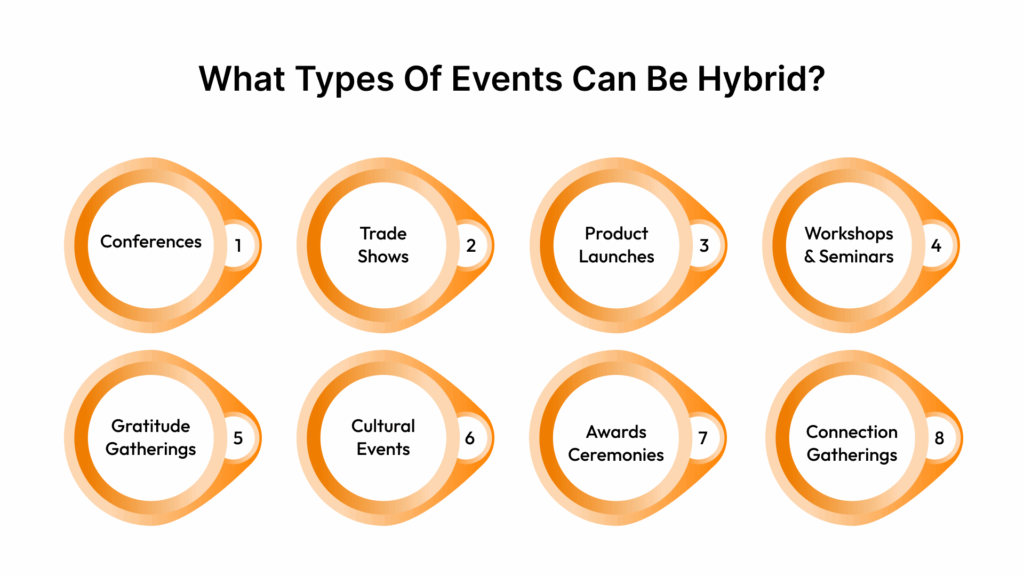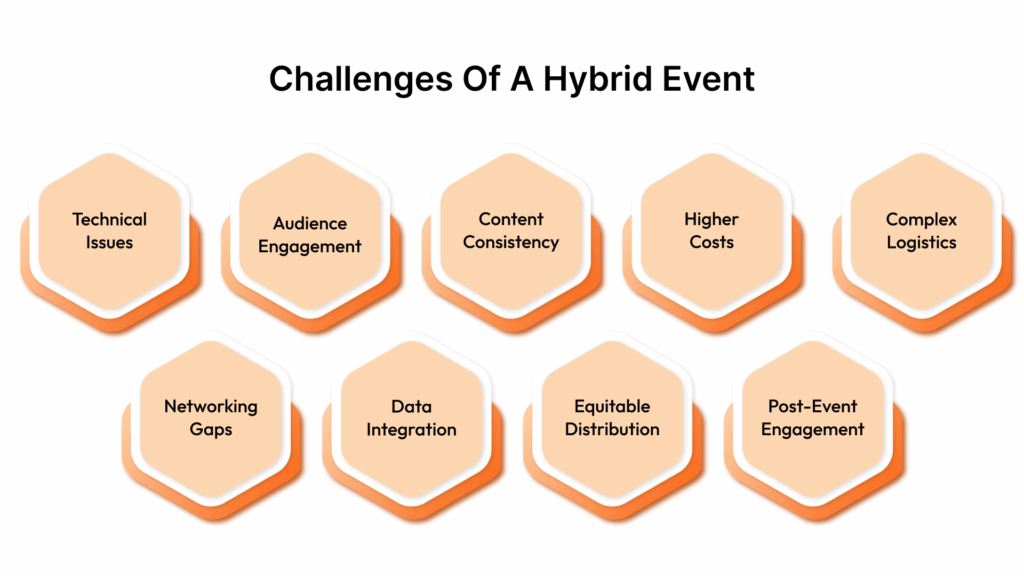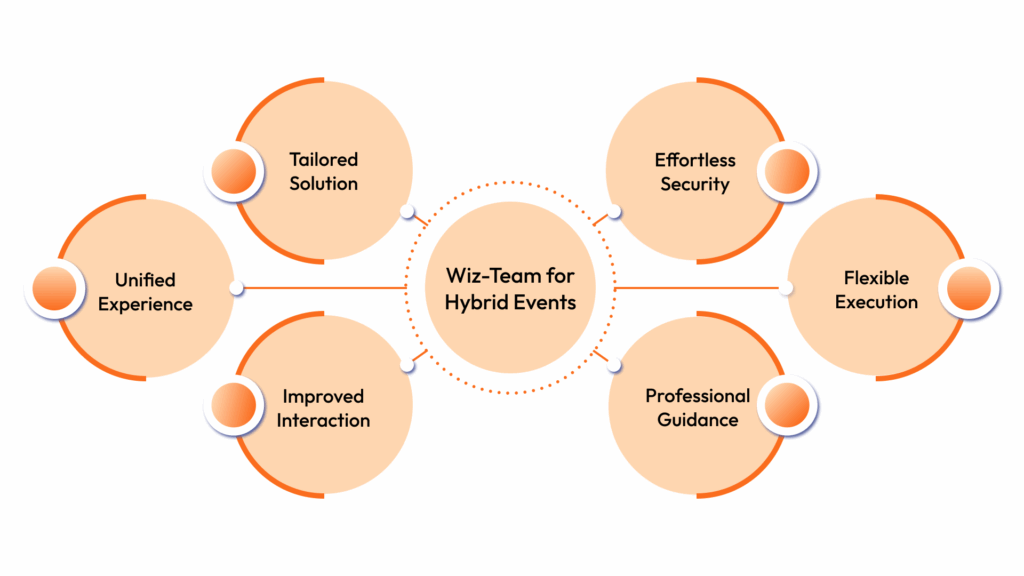While in-person events still hold sway, the allure of virtual and hybrid formats is undeniable. In fact, 90% of event organizers predict that all large-scale events will be remote or hybrid over the next two years.
While demand is skyrocketing, only 35% of events are held virtually, and 5% of events are currently being held in hybrid formats. This reveals a significant gap between what attendees want and what organizers are able to deliver.
As more planners explore the potential of hybrid events, the question arises: What exactly is a hybrid event, and how can it cater to both in-person and virtual audiences?
This guide will help you understand the core elements of hybrid events, the benefits they offer, and the key challenges organizers face. It will also explore the strategies and tools that can help overcome these obstacles, ensuring a truly inclusive and impactful experience for all attendees.
Key Summary (TL;DR)
Hybrid events combine in-person and virtual elements to create inclusive, interactive experiences that cater to diverse audience preferences.
Understand the differences between hybrid, in-person, and online events to select the best format based on goals, reach, and logistics.
Manage venue tech, audience coordination, content delivery, and seamless integration of physical and virtual components.
Overcome challenges like technical issues, engagement gaps, and complex logistics using flexible platforms like Wiz-Team’s Event-Works.
What Are Hybrid Events?

Hybrid events are a combination of in-person and virtual elements designed to create an immersive, interactive experience for both on-site and online attendees. However, to understand what a hybrid event truly is, it’s important to first clarify what it’s not.
A hybrid event is not:
Simply a virtual event with a few attendees watching from their homes while others are at the venue.
A one-dimensional experience where the online participants are treated as secondary, disconnected from the event’s main activities.
A broadcast of an in-person event, where remote participants watch without the ability to engage with the content or interact with others.
A hybrid event extends the event’s reach, offering both the intimacy of physical presence and the accessibility of virtual participation. It allows attendees to choose the format that suits them, making events more inclusive, scalable, and flexible.
It isn’t just about “being online” or “being at the venue.” It’s about creating an interactive, collaborative, and inclusive event experience that transcends physical and digital boundaries, ensuring that everyone can participate, no matter where they are.
What Are the Components of Hybrid Events?

Hybrid events combine live, in-person experiences with robust virtual components, allowing attendees to participate from anywhere and interact in real time.This integrated approach ensures all attendees can connect, engage, and access event content equally, regardless of location
Live Streaming
This allows remote participants to watch sessions, keynotes, or presentations in real-time, providing them with a direct connection to the event as if they were there in person.
Audience Interaction
To keep virtual attendees engaged, hybrid events often include features like live Q&A sessions, polls, and chat rooms, allowing everyone to participate in discussions and interactions.
Virtual Booths
Just like in-person trade shows, exhibitors set up digital booths where virtual attendees can explore products, view demos, and communicate with representatives.
Wiz-Team’s Event-Works modular platform is designed to be highly flexible and customizable, supporting integration with a variety of APIs to extend its capabilities. You can customize every part of your hybrid event, integrate your preferred live streaming provider, add interactive Q&A or polls, and design virtual booths that fit each exhibitor’s brand.
Event-Works adapts to your unique requirements, supporting everything from small meetings to large international events, never forcing you into a one-size-fits-all solution.
Let’s now compare the formats of events so you can gain a clearer understanding of how each option aligns with your event goals, audience needs, and logistical considerations.
What Are The Differences Between Hybrid Events, In-Person Events And Online Events?
This section breaks down the practical differences between hybrid, in-person, and online events, so you can choose the right format to match your audience’s preferences and your event objectives.
Hybrid Events vs Online Events
Here’s a quick comparison of hybrid and online events to help you decide which format best fits your goals and audience needs:
Feature | Hybrid Events | Online Events |
Audience Reach | Global, accessible to both in-person and remote audiences | Global, accessible from anywhere |
Engagement | High both physical and virtual interactions | Medium, but can vary greatly based on platform |
Cost Considerations | Higher cost but can be scaled and accessible | Lower cost as there are no venue or travel expenses |
Networking Opportunities | Both physical and virtual networking opportunities | Limited, mostly virtual networking options |
Flexibility | Highly flexible with in-person and remote options | Highly flexible; virtual participation only |
Understanding these differences is the first step, next, let’s explore how to decide when a hybrid format is the right choice for your event.
When to Host a Hybrid Event?
Hybrid events are a great choice when you want to combine the benefits of both in-person and virtual experiences. They are particularly useful in several scenarios:
1. When your audience is spread out geographically
If you want to reach people who can’t attend in person, a hybrid event allows you to include both local and global participants without compromising the experience for either group.
For large-scale events
Hybrid events work well when you’re dealing with a large number of attendees, making it impossible to have everyone in the same physical location. By offering a virtual component, you can ensure that more people can participate without worrying about space limitations or travel costs.
When your attendees have varying preferences
Some people prefer being physically present, while others might be more comfortable attending virtually. Hybrid events allow you to cater to both types of attendees, giving them the flexibility to choose how they want to participate.
If you need to extend your event’s reach
Hybrid events help you reach a broader audience, whether it’s through streaming sessions or offering on-demand content after the event. This way, you can maximize your event’s impact even after it’s over.
What Types of Events Can Be Hybrid?

Hybrid events are ideal for a variety of event types, particularly when the goal is to reach a wider audience and offer flexibility in how people participate. The following events work especially well in a hybrid format.
Event Type | Hybrid Event Description |
Conferences | In-person speakers combined with virtual sessions, allowing attendees to join on-site or online. |
Trade Shows | Exhibitors showcase products physically and virtually, engaging both in-person and remote visitors. |
Product Launches | Live demonstrations at a venue are streamed simultaneously to a global online audience. |
Workshops and Seminars | Hands-on learning for in-person attendees, streamed live for virtual participants. |
Client Appreciation Events | Intimate local events with a virtual experience for clients who cannot attend in person. |
Festivals and Performances | Live concerts or theatre shows are streamed online to reach a wider audience. |
Awards Ceremonies | Live venue ceremonies are streamed for remote viewers to join the celebration. |
Networking Events | Real-time networking for both on-site and virtual attendees using event platforms or apps. |
Now that you know the possibilities, let’s break down how hybrid events actually function in practice.
Understanding How Hybrid Events Work
Hosting a hybrid event is like orchestrating two parallel worlds, one where people are physically gathered in a venue, and the other where attendees are joining from across the globe. The key challenge? Making sure both worlds work together smoothly. Here’s how it all unfolds.
1. The Logistics Behind a Hybrid Event
A hybrid event requires careful planning, like juggling both an in-person conference and a virtual summit at the same time. Here’s how you make it happen:
1.1 The Right Venue
You need a venue that can handle the technical side, like high-speed internet, lighting, and space for cameras and tech setups. It needs to accommodate not just people but also all the digital equipment to broadcast the event to the world.
1.2 Tech Setup
The goal is to stream a live keynote to thousands while keeping the sound and visuals crystal clear. A solid tech setup is a must: cameras, microphones, and streaming tools that work in sync.
1.3 Support Across Realms
You’ll need dedicated staff for both the in-person and virtual parts of the event. In-person staff takes care of registrations, logistics, and helping attendees navigate the venue, while virtual assistants handle tech support, audience management, and online engagement.
1.4 Audience Coordination
From virtual registrations to managing in-person check-ins, audience management becomes a balancing act. Systems need to ensure seamless access for both crowds, keeping everyone in the loop, whether they’re physically present or attending from afar.
2. Managing the In-Person Experience In A Hybrid Event
When attendees are on the ground, it’s all about providing them with a memorable, interactive experience. Here’s how to create that buzz in person:
2.1 Registration and Flow
No one wants to stand in line. Digital check-ins, kiosks, and apps make the registration process quick and hassle-free. Plus, clear signage and staff are essential for guiding people to sessions, exhibitors, and networking areas.
2.2 Creating Engagement
In-person engagement goes beyond just watching speakers on stage. Interactive Q&As, live polls, and workshops help keep everyone engaged.
Tools like Wiz-Team’s Event-Works custom apps make it easy for attendees to ask questions, vote on topics, and even shape session content in real-time, turning passive audiences into active participants.
2.3 Managing Event Flow
In-person logistics matter. Making sure people know where to go, when to take breaks, and how to get the most out of the event is key. Staff and technology should work together to keep everything on schedule and organized.
2.4 Tech for On-Site Interactivity
Even though attendees are physically present, you can enhance their experience with in-venue apps, digital signage, and interactive kiosks. These tools provide them with session schedules, speaker bios, or instant event updates.
3. Creating the Virtual Attendee Experience in a Hybrid Event
While the in-person crowd is bustling around, virtual attendees need a platform that makes them feel connected, engaged, and a part of the action. Here’s what makes it work:
3.1 Streaming the Action
Broadcasting live sessions and workshops to remote attendees requires a strong streaming platform. Whether it’s Zoom, YouTube, or a dedicated event platform, the goal is to ensure the remote audience gets a front-row seat to the action with clear visuals, good sound, and seamless connectivity.
3.2 Interactive Features
Virtual audiences should never feel left out. Integrating features like live chats, Q&As, and polls ensures they can interact with speakers, ask questions, and participate in real time. These tools keep online engagement lively and interactive.
3.3 Virtual Booths
Virtual trade show booths let exhibitors display their products to a broader audience. Attendees can visit booths, watch demos, download materials, and even chat live with exhibitors, just like they would in person.
3.4 Networking in the Virtual World
Virtual attendees don’t miss out on networking either. Breakout rooms, chat features, and even one-on-one video calls allow people to network, meet new contacts, and attend virtual “meet-ups,” creating a social experience from afar.
3.5 On-Demand Content
Not everyone can join live, and that’s fine. Offering recorded sessions after the event means virtual attendees can catch up on anything they missed, giving them flexibility without losing valuable content.
4. Integrating In-Person and Virtual Components
Now comes the trickiest part: making sure both sides of the event feel like they’re part of the same experience. Here’s how you tie everything together:
4.1 Unified Platform
Utilize a single platform (such as WizTeam) to manage registration, content delivery, and engagement, ensuring that both virtual and in-person attendees have access to the same resources.
4.2 Live Streaming with Interaction
Allow virtual attendees to participate in real-time through Q&A, live polls, and chats, making the experience interactive and connected.
4.3 Simultaneous Engagement
Enable real-time engagement for both in-person and virtual attendees through shared polls, Q&As, and networking spaces.
4.4 Real-Time Communication
Maintain seamless communication between virtual and in-person teams to quickly address any issues and ensure a smooth experience for all.
4.5 Hybrid Networking
Provide equal networking opportunities through virtual matchmaking tools, live chats, and networking rooms for both in-person and virtual participants.
At the 2024 Major Events International (MEI) Hosts & Federations Summit in Lausanne, Wiz-Team’s Event-Works platform managed guest registration, accreditation, access control, and onsite support—all within one seamless system. The platform also delivered a personalized mobile app called EWToGo for delegates, ensuring attendees could check in quickly, access event information instantly, and connect throughout the summit.
What Are the Challenges Of A Hybrid Event?

While the concept of combining in-person and virtual experiences holds immense potential, it also introduces a series of challenges. Below, the key challenges of managing a hybrid event are discussed:
Technical Issues: Ensuring seamless live streaming and reliable technology support for both in-person and virtual attendees is critical, as any disruptions can negatively impact the experience, especially for remote participants. Managing complex setups and troubleshooting in real time adds to the challenge.
Audience Engagement: Keeping both physical and virtual audiences equally engaged requires thoughtful planning and the use of interactive tools like live Q&A, polls, and chat features. Without these, virtual attendees may feel disconnected or less involved.
Content Consistency: Delivering content that resonates equally with in-person and online participants is essential. The event must maintain high-quality broadcasts and adapt presentations to engage both groups without compromising the event’s core message.
Higher Costs: Hybrid events often incur greater expenses due to venue rentals, technology investments (such as cameras and streaming software), and platform fees. Careful budgeting and resource allocation are necessary to manage these costs effectively.
Complex Logistics: Coordinating schedules across different time zones, managing smooth transitions between physical and virtual sessions, and ensuring secure access for all attendees makes logistics more complicated than traditional events.
Networking Gaps: Facilitating meaningful networking opportunities for virtual attendees is challenging since they miss out on spontaneous in-person interactions. Digital matchmaking tools, breakout rooms, and real-time communication features are needed to bridge this gap.
Data Integration: Collecting and consolidating engagement data from both in-person and virtual participants requires efficient systems. Without unified data management, it’s difficult to accurately measure event success and gather insights for improvement.
Delivering Equal Value: Ensuring virtual attendees feel as valued as those attending in person is a core challenge. Both groups should have access to the same content, networking, and interactive experiences to foster inclusivity.
Post-Event Engagement: Maintaining momentum after the event ends is important, especially for virtual participants. Providing on-demand content and continued networking opportunities helps sustain engagement and strengthens community building.
Addressing these challenges can quickly become overwhelming. However, Wiz-Team and its Event-Works App provide the tools needed to simplify hybrid event management and boost engagement for all attendees.
Optimizing Hybrid Events Engagement with the Event-Works App

Wiz-Team’s flagship platform, Event-Works, is an all-in-one, modular event management software designed to be highly configurable and scalable, supporting a wide range of event types and sizes, from small meetings to large international gatherings.
The digital-first approach of Event-Works is built to adapt to the unique and evolving needs of each event, giving organizers the flexibility to manage both in-person and remote participants seamlessly.
At SportAccord 2024, Wiz-Team provided its platform and a custom-branded mobile app to support over 1,500 delegates, offering features such as registration, agenda management, and networking. These are some of the key components for hybrid event success. Our solutions enable real-time attendee engagement, personalized experiences, and efficient coordination of both physical and virtual elements, which are essential for hybrid events.
Here’s how Wiz-Team can support your hybrid event:
1. Modular, Customizable Platform
Event-Works is a flexible, all-in-one event management platform with customizable tools that easily scale to meet the evolving needs of any event, including hybrid formats. Organizers can activate or deactivate modules as needed to seamlessly support both onsite and remote attendees.

2. Integrated Participant Journey
The platform manages the entire participant journey, from registration and accreditation to access control, agenda management, and communications, seamlessly serving both onsite and remote attendees.
3. Enhanced Engagement and Networking
Wiz-Team’s solutions enable networking and connections among delegates, speakers, and exhibitors, no matter their location. Features like personalized agendas, real-time updates, and integrated communication tools help all participants engage fully with the event and each other.
4. Seamless Access and Security
Personalized QR codes and digital credentials allow for secure, contactless access to physical venues, while virtual attendees benefit from secure logins and access to digital event spaces.
5. Scalable and Agile Delivery
Event-Works is agile and scalable, suitable for events of all sizes, from small meetings to large international congresses. Its modular design lets organizers quickly adjust to changes in format, audience size, or operational needs, ensuring hybrid events can grow or pivot smoothly.
6. Expert Support and Consultancy
Wiz-Team surrounds its technology with experienced event professionals who provide consultancy, delivery, and data management services, helping organizers manage the complexities of hybrid event planning and execution.
But don’t just take our word for it—here’s what our clients say about us:
“ Event-Works provides us with a wonderful tool where we can create solutions efficiently and cost-effectively for our clients. Johann and his team are always available to help us if we need additional support or a customized offering.” GILLIAN HAMBURGER, President, Além International |
Conclusion
As organizers, it’s important to recognize that while hybrid formats offer incredible opportunities to broaden your reach and provide flexibility for attendees, they come with unique challenges that require careful planning and execution. From technical complexities to ensuring meaningful engagement for both in-person and virtual audiences, the road to a successful hybrid event isn’t always straightforward.
However, with the right mindset and the right tools, these challenges are entirely manageable. For organizers seeking flexibility, Event-Works offers a platform that adapts to the unique needs of each event. Its customizable features allow you to design the perfect hybrid experience, effortlessly integrating the physical and virtual components for a truly seamless event.
Plan your next hybrid event with Event-Works for a successful experience that thoughtfully bridges the gap between in-person and virtual attendees.
FAQs
What kind of technology setup is required for a successful hybrid event?
A stable, high-speed internet connection, professional audio-visual equipment (cameras, microphones, lighting), and a robust hybrid event platform are essential. Testing all technology in advance and having backup solutions for streaming and connectivity are also critical for smooth execution.
How can I ensure equal engagement for both in-person and virtual attendees?
Use interactive features like live Q&A, polls, chat rooms, and breakout sessions. Assign moderators to facilitate participation and design the agenda to include activities that encourage interaction from both audiences.
What should I look for when choosing a venue for a hybrid event?
Select a venue with strong internet connectivity, flexible space for both physical and virtual production setups, and built-in AV infrastructure. The layout should support both in-person engagement and technical requirements for live streaming.
How do I handle networking opportunities in a hybrid event?
Leverage digital tools such as virtual meeting rooms, matchmaking algorithms, and scheduled networking sessions. Provide options for both spontaneous and structured interactions to help online and onsite attendees connect.
What are the best practices for promoting a hybrid event?
Develop separate marketing strategies for in-person and virtual audiences, using targeted emails, social media, and partnerships. Share clear instructions on how to participate in both formats and use engaging teaser content to generate excitement.
#WizJourney









